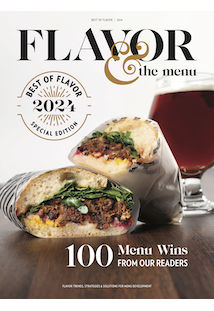
SPONSORED CONTENT
A New Era for Beef on the Menu
Embracing a modern approach to menuing and marketing Australian-sourced, grassfed beef
SPONSORED CONTENT
A New Era for Beef on the Menu
Embracing a modern approach to menuing and marketing Australian-sourced, grassfed beef
One look at the menu of modern steak or meat-centric restaurants and it’s easy to conclude that we’re in a new era of red meat consumption. It’s all about maximum choice and personalization for the guest, with the days of simply choosing between filet mignon or porterhouse a thing of the past. Will it be grassfed or grain-fed? Imported or domestic? Six ounces or 48 ounces, or somewhere in between?
“I like to have the steak menu read like a wine list,” says Chef Danny McCallum of Toronto’s Jacobs & Co Steakhouse. “Do you prefer California Cab or Bordeaux? Angus from Kansas or Australia? It’s all about the terroir in these cases.”
What’s driving the shift is a new attitude towards red meat, with guests looking for more indicators of quality and provenance across the spectrum of dining occasions. They still very much crave beef, but want value for the money and to feel good about the indulgence, too.
Indeed, Chef McCallum has seen an uptick in demand for grassfed cuts like the ones he sources from Australia, as well as more Wagyu from a variety of origins. And he’s not alone. Look at STK, the sizzling steakhouse brand with locations in 21 U.S. cities and nine more international locations. The brand’s signature bar food, the Lil’ Brgs, is a Wagyu beef slider that provides an approachable and fun happy hour bite, while World of Wagyu flights allow guests to sample small portions of the premium beef from Japan, Australia and America in cuts from striploin to ribeye and skirt.
At Gibsons Restaurant Group, Chef Dan Huebschmann has seen Gibsons Grassfed Angus steaks become a top-seller at Gibsons Italia concept in Chicago. He’s also witnessed exponential growth for the grassfed dish at The Boathouse, a steak-and-seafood destination at Disney World Resort. “We vetted domestic cuts, and we vetted Australian cuts. There really was no competition,” Chef Huebschmann says. “When it comes to finding 100 percent grassfed beef with all of the things people are looking for—free range, no added hormones, no antibiotics—there’s no competing with Australia, especially at the quality level we’re looking for.”
Looking abroad to places like Australia for sourcing beef will be a necessity in 2024 for many North American operators, as domestic supplies will be at their lowest level in many decades due to years of drought conditions for U.S. herds. But with consumers now more acclimated to a wider array of offerings and countries of origin, it’s an opportunity for operators to appeal to guests through a differentiating value proposition, whether it’s Wagyu, grassfed or grain-fed. The more variety and more indicators of quality, the better.
Aussie Beef & Lamb works directly with food professionals to achieve success with Australian grassfed beef, grain-fed beef, Wagyu, lamb and goat, supporting them with new product development, menu ideation and customized marketing support.
Doug McNicholl, Regional Manager, [email protected]
Sabina Kindler, Business Development Manager, [email protected]
For more on the Aussie red meat sustainability story, visit https://www.foodservice.aussiebeefandlamb.com/
One look at the menu of modern steak or meat-centric restaurants and it’s easy to conclude that we’re in a new era of red meat consumption. It’s all about maximum choice and personalization for the guest, with the days of simply choosing between filet mignon or porterhouse a thing of the past. Will it be grassfed or grain-fed? Imported or domestic? Six ounces or 48 ounces, or somewhere in between?
“I like to have the steak menu read like a wine list,” says Chef Danny McCallum of Toronto’s Jacobs & Co Steakhouse. “Do you prefer California Cab or Bordeaux? Angus from Kansas or Australia? It’s all about the terroir in these cases.”
What’s driving the shift is a new attitude towards red meat, with guests looking for more indicators of quality and provenance across the spectrum of dining occasions. They still very much crave beef, but want value for the money and to feel good about the indulgence, too.
Indeed, Chef McCallum has seen an uptick in demand for grassfed cuts like the ones he sources from Australia, as well as more Wagyu from a variety of origins. And he’s not alone. Look at STK, the sizzling steakhouse brand with locations in 21 U.S. cities and nine more international locations. The brand’s signature bar food, the Lil’ Brgs, is a Wagyu beef slider that provides an approachable and fun happy hour bite, while World of Wagyu flights allow guests to sample small portions of the premium beef from Japan, Australia and America in cuts from striploin to ribeye and skirt.
At Gibsons Restaurant Group, Chef Dan Huebschmann has seen Gibsons Grassfed Angus steaks become a top-seller at Gibsons Italia concept in Chicago. He’s also witnessed exponential growth for the grassfed dish at The Boathouse, a steak-and-seafood destination at Disney World Resort. “We vetted domestic cuts, and we vetted Australian cuts. There really was no competition,” Chef Huebschmann says. “When it comes to finding 100 percent grassfed beef with all of the things people are looking for—free range, no added hormones, no antibiotics—there’s no competing with Australia, especially at the quality level we’re looking for.”
Looking abroad to places like Australia for sourcing beef will be a necessity in 2024 for many North American operators, as domestic supplies will be at their lowest level in many decades due to years of drought conditions for U.S. herds. But with consumers now more acclimated to a wider array of offerings and countries of origin, it’s an opportunity for operators to appeal to guests through a differentiating value proposition, whether it’s Wagyu, grassfed or grain-fed. The more variety and more indicators of quality, the better.
Aussie Beef & Lamb works directly with food professionals to achieve success with Australian grassfed beef, grain-fed beef, Wagyu, lamb and goat, supporting them with new product development, menu ideation and customized marketing support.
Doug McNicholl, Regional Manager, [email protected]
Sabina Kindler, Business Development Manager, [email protected]
For more on the Aussie red meat sustainability story, visit https://www.foodservice.aussiebeefandlamb.com/








